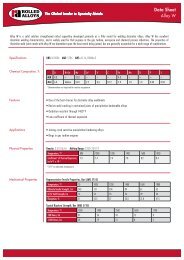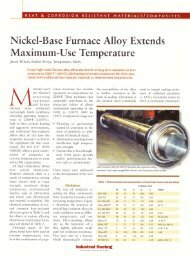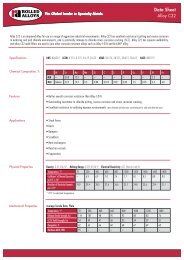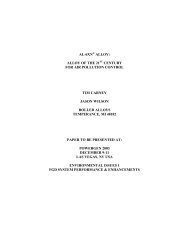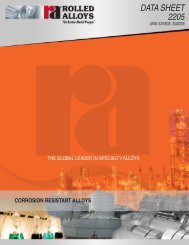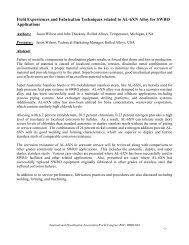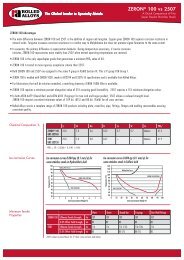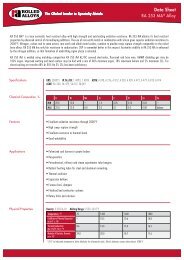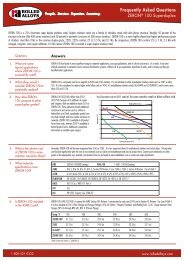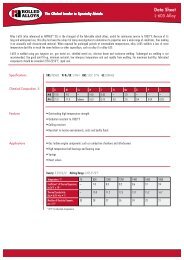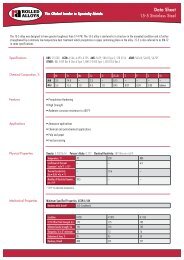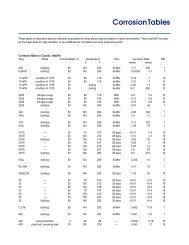RA333 Data Sheet [Heat Resistant Alloys] - Rolled Alloys
RA333 Data Sheet [Heat Resistant Alloys] - Rolled Alloys
RA333 Data Sheet [Heat Resistant Alloys] - Rolled Alloys
- No tags were found...
Create successful ePaper yourself
Turn your PDF publications into a flip-book with our unique Google optimized e-Paper software.
Machining<strong>RA333</strong> ®<strong>RA333</strong> requires low cutting speeds, roughly 25% ofthose for AISI B1112 steel, and heavy feeds. Set upshould be rigid, tools ground and stoned sharp.The suggested cutting fluid is a sulpho-chlorinatedpetroleum oil containing active sulfur and about8-10% fatty oil. It may be blended with equal amountsof paraffin oil. Water soluble oils or chemical emulsionsare also used, particularly with carbide tools. All tracesof cutting fluid must be removed prior to welding,annealing or use in high temperature service.Suggested Speeds and FeedsOperation Tool Speed Feed, inch per rev. Depth of cut, inchMaterial SFPM rough finish rough finishTurning, M42, M47 20-25single point .010 .007 .100 .025and box tools C2, C3 70-90carbideDrilling M42 20 .002-.004, drilldia. 1/8 - 3/4 inchM1,Tapping M7, M10 10 — — — —Broaching M42 8 chip load .002 inches per toothFeed, inches per toothDepth of cutCutter diameter, inchesEnd 1/4 1/2 3/4 1-2Milling M42 15 .002 .002 .003 .004 .050-peripheral C2 60 .001 .002 .003 .004carbideFeed, inches per revolutionM42 20 Reamer diameter, inchesReaming 1/8 1/4 1/2 1 1-1/2 2C2 60 .002 .006 .008 .010 .012 .014carbideM2, — Speed, surface feet per minute:Die M7, — 4-6 5-8 6-10 8-12Threading M10 — Threads per inch:7 or less 8-15 16-24 25 and up4
<strong>RA333</strong> ® 5<strong>Heat</strong> Treatment<strong>Heat</strong> TreatmentMost <strong>RA333</strong> fabrications are not heat treated afterforming or welding. If a full anneal is desired, heat2000-2150°F (aim 2000-2050°F for sheet gauges),rapid air cool or water quench. Residual stresses andsome of the work hardening from severe formingoperations may be relieved by heating 1850-1900°F,one hour per inch of thickness, air cool.<strong>RA333</strong> is a fully austenitic material and cannot behardened or strengthened by heat treatment.Effect of Annealing TemperatureOn Hardness of Cold <strong>Rolled</strong> <strong>RA333</strong> 12Annealing Hardness at Indicated % Cold Reduction, Rockwell BTemp. °F (°C) 0 10 20 40 60As <strong>Rolled</strong> 94 105 108 (RC 31) 111 (RC 38) 112 (RC 40)1400 (760) — 102 106 (RC 29) 111 (RC 37) 113 (RC 40)1500 (816) — 102 103 111 (RC 37) 109 (RC 35)1600 (871) — 101 102 99 1011700 (926) — 94 93 98 981800 (981) — 93 93 98 981900 (1036) — 90 90 95 962000 (1149) — 89 90 90 90
Physical Properties<strong>RA333</strong> ®Physical PropertiesDensity 10.294 lb/cu.in.8140 kg/m 3Melting Range 1,22375-2450°F1300-1345°CPermeability, at H-200 oersted, roomtemperatureμ = 1.004 annealed1.006 cold rolled 20%1.01 cold rolled 50%Cryogenic Permeability 3100-200K (-280 to -100°F) μ = 1.01, measured withan AC technique, field strength 0.1 oersted at 10Hz.<strong>RA333</strong> is a spin glass with spin-freezing temperatureof about 8.5K (-444.4°F)Specific <strong>Heat</strong> 1Temperature°F (°C) Btu/lb°F J/kg•K100 (38) 0.072 300300 (149) 0.081 340500 (260) 0.090 380700 (371) 0.100 420900 (482) 0.108 4501100 (593) 0.118 4901300 (704) 0.126 5301500 (816) 0.136 5701700 (927) 0.145 6101900 (1036) 0.154 6502000 (1093) 0.159 670Thermal Conductivity 4Temperature°F (°C) Btu•ft/ft 2 •hour °F W/m•K77 (25) 6.41 11.1200 (93) 7.02 12.1400 (204) 8.06 13.9600 (315) 9.13 15.8800 (426) 10.2 17.61000 (538) 11.3 19.51200 (648) 12.4 21.41400 (760) 13.5 23.31600 (871) 14.5 25.11800 (981) 15.6 27.02000 (1093) 16.7 28.9Electrical Resistivity 4,5Temperature°F (°C) ohm•circ mil/ft microhm•m75 (25) 688 1.144400 (204) 716 1.190600 (315) 729 1.212800 (426) 740 1.2301000 (538) 749 1.2451200 (648) 755 1.2551400 (760) 760 1.2641600 (871) 765 1.2711800 (981) 769 1.278Mean Coefficient of ThermalExpansion 6Temperature Range in/in °F m/m•K°F (°C) x 10 -6 x 10 -670-200 (21-93) 7.0 12.670-500 (21-260) 8.0 14.470-1000 (21-538) 8.6 15.570-1200 (21-648) 9.0 16.370-1400 (21-760) 9.3 16.770-1500 (21-816) 9.3 16.870-1600 (21-871) 9.4 16.970-1700 (21-926) 9.5 17.270-1800 (21-981) 9.7 17.56
Average Short-timeTensile Properties<strong>RA333</strong> ®RT to 2200 °F (1204 °C)0.2% Yield Elongation in ReductionTemperature Tensile Strength, Strength 2” (50 mm) of Area°F (°C) psi (MPa) psi (MPa) or 4D, % %75 (24) 107,000 (738) 47,000 (324) 48 62200 (93) 100,200 (691) 41,600 (287) 48 55300* (149) 96,400 (665) 39,500 (272) 46 54400 (204) 96,100 (663) 37,000 (255) 49 59500* (260) 91,800 (633) 34,800 (240) 47 52600 (316) 92,500 (638) 32,500 (224) 54 60700* (371) 89,500 (617) 33,500 (231) 51 48800 (427) 89,900 (620) 31,500 (217) 55 57900* (482) 86,700 (598) 30,700 (212) 52 471000 (538) 85,400 (589) 30,800(212) 53 561100 (593) 79,600 (549) 29,300 (202) 49 471200 (649) 73,600 (507) 30,700 (212) 43 411300* (704) 61,500 (424) 27,200 (188) 42 411400 (760) 53,900 (372) 28,900 (199) 62 501500 +a (816) 40,700 (281) 30,400 (210) 94 711500 *b (816) 41,600 (287) 30,500 (210) 24 --1600 (871) 27,500 (190) 23,900 (165) 75 741800 (982) 15,700 (108) 12,100 (83.4) 64 692000+ b (1093) 7,400 (51.0) 6,500 (44.8) 25 --2100* b. (1149) 6,600 (45.5) 5,000 (34.5) 36 --2200* b (1204) 4,000 (27.6) 3,500 (24.1) 106 71* average of 3 tests+ average of 2 testsa bar onlyb sheet only8
Effect of Elevated Temperature Exposure On andShort-time Elevated Temperature Propertiesof Mill Annealed Plate and Bar 1,100.2% Offset Red. Charpy V-notchTest Aging Aging Ultimate Yield Elon- of Hardness Impact LateralTemp. Temp. Time Tensile Strength gation Area Rockwell Energy Expansion°F (°C) °F (°C) hours psi (MPa) psi (MPa) % % B ft-lb (J) inch (mm)<strong>RA333</strong> ®<strong>Data</strong> are average values of from two to nine tests.980 (27) none -- 104,500 (721) 45,600 (314) 50 59 84 43.3 0.040(58.7) (1.0)80 (27) 1200 (649) 1000 110,000 (785) 52,200 (360) 36 34 -- 19.5 0.019(26.4) (0.48)80 (27) 1400 (760) 1000 106,700 (736) 46,000 (317) 27 27 89 -- --80 (27) 1400 (760) 1000 105,400 (727) 50,700 (350) 11 10 96 -- --80 (27) 1500 (816) 1000 109,300 (754) 52,600 (363) 20 16 -- 7.5 0.005(10.2) (0.13)80 (27) 1800 (982) 1000 94,900 (654) 38,000 (262) 34 26 -- 47.8 0.037(64.8) (0.94)1200 (649) 1200 (649) 1000 77,000 (531) 34,400 (237) 43 47 -- -- --1500 (816) 1500 (816) 1000 40,800 (281) 25,800 (178) 73 72 -- -- --1800 (982) 1800 (982) 1000 14,200 (97.9) 11,300 (77.9) 90 83 -- -- --1800 (982) none -- 15,600 (107.6)10,300 (71.0) 89 78 -- -- --Effect of Annealing Treatment on Tensile Properties of Aged <strong>RA333</strong> 11Ultimate 0.2% Offset Elon- ReductionStrength Yield Strength gation ofCondition psi (MPa) psi (MPa) % Area, %Annealed 102,700 (708) 42,400 (292) 51.0 53.2Annealed + aged 114,800 (792) 58,600 (404) 5.0 4.7Annealed + aged + 112,700 (777) 45,200 (312) 35.5 35.71800°F 1 hr.Annealed + aged + 109,300 (754) 43,600 (301) 41.0 47.91800°F 2 hr.Annealed + aged + 108,700 (749) 42,500 (293) 42.0 48.51800°F 4 hr.Annealed + aged + 105,800 (729) 43,400 (299) 43.5 48.81900°F 1 hr.Annealed + aged + 106,100 (732) 42,400 (292) 43.0 48.31900°F 2 hr.Annealed + aged + 105,600 (728) 43,800 (302) 47.0 51.61950°F 15 min.Material annealed 2050°F, (1120°C) air cool. Aging performed for 1000 hours at 1400°F (760°C). Bar stock from heat 2888, chemistry:C Mn P S Si Ni Cr Mo Co W.042 1.67 .015 .007 1.40 45.21 25.96 2.90 3.17 3.06
Effect of Elevated Temperature ExposureOnShort-time Properties of ShieldedMetal Arc Weldment 1<strong>RA333</strong> ®TensileFailureAgingLocationTemperature Ultimate 0.2% Offset Red. B=Base Charpy V-NotchTest 1000 hour Tensile Yield Elon- of metal Impact LateralTemperature exposure Strength Strength gation Area W=weld Energy Expansion°F (°C) °F (°C) psi (MPa) psi (MPa) % % metal ft-lb (J) inch (mm)80 (27) none 110,200 (760) 54,800 (378) 33.3 44.1 B 63.2(85.7) 0.051 (1.3)80 (27) 1200 (649) 111,600 (769) 59,800 (412) 25.8 34.2 B 26.0(35.2) 0.019 (0.48)80 (27) 1500 (816) 109,000 (748) 58,100 (401) 8.0 9.4 W 4.2(5.7) 0.002 (0.05)80 (27) 1800 (982) 72,400 (499) 39,400 (272) 7.6 10.4 W 14.2(19.3) 0.016 (0.41)1200 (649) 1200 (649) 80,200 (553) 39,800 (274) 30.7 39.4 B -- --1500 (816) 1500 (816) 46,500 (321) 26,200 (181) 50.9 63.4 B -- --1800 (982) 1800 (982) 15,100 (104) 14,300 (98.6) 64.6 84.0 B -- --1800 (982) none 16,200 (112) 10,900 (75.2) 50.4 78.9 B -- --Charpy and unexposed room temperature data average of three tests, balance of tensile data average of two tests.Weldment in center of tensile gauge length. Charpy notch in weldment, parallel to weldment centerline. Allspecimens from 1” (25.4mm) plate, double V weld joint preparation.10
<strong>RA333</strong> ® 11Effect of Cold Drawing on TensileProperties of <strong>RA333</strong>Starting material hot rolled 3/4” dia. bar, annealed 2050°F, water quench. <strong>Heat</strong> 38253.Effect of Temperature on Tensile Properties of 20% Cold Drawn BarTensile 0.2% Offset Elongation ReductionTest Temp Strength Yield Strength in 4D of°F (°C) psi (MPa) psi (MPa) % Area %75 (24) 147,050 134,450 17.8 57.4(1014) (927)450 (232) 129,650 125,450 15.2 54.4(894) (865)
Low Cycle FatigueRoom Temperature<strong>RA333</strong> ®A, C As mill annealed 2050°F (1120°C), fan cool, grain size ASTM 6.5 and laboratory solution annealed 2200°F(1204°C) in argon, warm (60°C) water quench, grain size ASTM 3.0B, D Solution annealed plus 1350°F (732°C) 16 hour age.All tests at room temperature on Instron fatigue tester 1312
<strong>RA333</strong> ® 13Low Cycle FatigueElevated Temperature1600°F, 16 cycles per minute.Material tested: 3/4” dia. hot rolled annealed bar, heat 38314.C Mn Si Ni Cr Mo Co W.066 1.68 1.00 44.91 24.65 2.86 2.77 2.51
Low Cycle Fatigueand Creep Strength<strong>RA333</strong> ®Low Cycle Fatigue<strong>RA333</strong> shaker hearth, one of twin hearths in a Surface Combustion furnace. Temperature 1600-1650°F (870-900°C),enriched endothermic atmosphere used for bright hardening and light carbonitriding.In service, the cyclic strains are rarely well defined. Thisshaker hearth furnace moves the work pieces along bya reciprocating motion of the hearth. Failure is usuallycombined mechanical fatigue and thermal strain at thecharge (cooler) end. This particular design in 3/8”(9.5mm) <strong>RA333</strong> plate lasted 22 months (or 16,000cycles). Previous cast 66% Ni, 17% Cr hearths gaveerratic life ranging upwards from 3 months.Creep StrengthAverage Stress, psi (MPa) for:Temperature Secondary Creep Rate of Total Creep in 10,000 hours, %°F (°C) 0.00001%/hr 0.0001%/hr 0.5 1.0 2.0 5.01100 (593) -- 22,000 (152) 19,000 19,500 20,500 22,000(131) (134) (141) (152)1200 (649) 6800 (46.9) 9,800 (67.6) -- -- -- --1300 (704) 5400 (37.2) 7,700 (53.1) -- -- -- --1400 (760) 4600 (31.7) 6,400 (44.1) 4,000 5,300 6,500 8,350(27.6) (36.5) (44.8) (57.6)1500 (816) 2900 (20.0) 4,200 (29.0) -- -- -- --1600 (871) 1900 (13.1) 2,700 (19.0) 2,350 2,450 2,800 2,950(16.2) (16.9) (19.3) (20.3)1700 (927) 1100 (7.58) 1,650 (11.4) -- -- -- --1800 (982) 560 (3.86) 880 (6.07) 700 770 820 850(4.83) (5.31) (5.65) (5.86)14
<strong>RA333</strong> ® 15Rupture StrengthAverage Stress, psi (Mpa), to Rupture forIndicated Time, Mill AnnealedTemperature100,000 hr°F (°C) 100 hr 1000 hr 10,000 hr (extrapolated)1100 (593) + 46000 (317) 34000 (235) 25000 (170) --1200 (649) 33500 (231) 23500 (162) 16500 (114) 11500 (79.3)1300 (704) * 24000 (165) 17000 (117) 12000 (82.7) 8400 (57.9)1400 (760) 18500 (128) 13000 (89.6) 9200 (63.4) 6500 (44.8)1500 (816) 13000 (89.6) 8600 (99.3) 5700 (39.3) 3700 (25.5)1600 (871) 8400 (57.9) 5100 (35.2) 3100 (21.4) 1900 (13.1)1700 (927) * 5600 (38.6) 3200 (22.1) 1800 (12.4) 1050 (7.24)1800 (982) 3600 (24.8) 1950 (13.4) 1050 (7.24) 580 (4.0)1900 (1038) * 2300 (15.9) 1200 (8.27) 630 (4.34) 330 (2.28)2000 (1093) 1500 (10.3) 720 (4.96) 360 (2.48) --2200 (1204) + 640 (4.41) 300 (2.07) 140 (0.96) --+ Single heat data* Interpolated by Larson-Miller techniqueT (C + logt) = Parameter, using C=15.65These creep and rupture data represent the average of tests run on bar and plate for times up to about 10,000 hours.The data are not the minimum properties at temperature. Actual design stresses must include a factor of safety, andtake into account the effects of thermal cycling, stress concentrations, thermal gradients and the corrosive environment.We offer for your consideration two different philosophies of setting maximum allowable design stress:1. Industrial furnace components are often designed to 50% of the stress for either 10,000 hour rupture, or 1% in10,000 hour minimum creep rate.2. Pressure vessels, where failure may entail danger or very high cost, are usually designed to 67% of the extrapolated100,000 hour rupture strength.
Total Creep<strong>RA333</strong> ®16
<strong>RA333</strong> ® 17Minimum Creep Rate
Rupture Strength<strong>RA333</strong> ®18
<strong>RA333</strong> ® 19Oxidation<strong>RA333</strong> has excellent oxidation resistance through 2200°F (1200°C).This is demonstrated by numerous test programs. Actual high temperature serviceperformance confirms these laboratory results.Valid comparison of the more oxidationresistant alloys may requiretesting for several thousand hours.This cyclic test shows relative alloybehavior after test times whichapproximate the expected service lifeof many components 14Cyclic oxidation resistance of high-temperature alloys at 1900°F (1038°C)The performance of these .120” (3mm) radiant tubes, operating under highly cyclicconditions over 1900°F (1038°C), compares reasonably with shorter time cyclic oxidationtests at 2100°F (1150°C)<strong>RA333</strong>RA310RA330RA309(RA309 and RA310 tubes burned out in service. <strong>RA333</strong> still in excellent condition.)
Oxidation<strong>RA333</strong> ®2100°F Oxidation Test Specimens, 2XRA309 (440 hr) RA310 (500 hr) RA330 (240 hr) <strong>RA333</strong> (400 hr)High weight gain, Low weight Moderate weight Low weight gain,local scale gain, local gain, uniform uniform adherentbreakdown scale breakdown scaling scaleTotal weight gain, mg/cm 2 , 20 hour cycles in air at 2100°F (1150°C)Alloy 100 hours 300 hours 400 hours<strong>RA333</strong> 3.8 6.8 8.3601 4.6 7.8 8.9RA310 5.91 10.1 13.2RA446 8.09 23.4 29.7RA330 6.4 15.2 28RA309 5.7 12.1 40800 17.4 80.7 109(RA330 showed rather large weight gain but oxidation was uniform, without the local scale breakdown of RA309and RA310.)Dynamometer TestsEngine dynamometer tests of alloy rings in insulatedexhaust pipes, leaded fuel 1800-1900°F (980-1400°C)showed the following weight change, mg/cm 2 , after1000 hours: 14<strong>RA333</strong> -0.34 RA330 -7.6718SR -2.09 800 -20.0601 4.36 * 310 -48.7Activation EnergyThe activation energy for parabolic oxidation of <strong>RA333</strong>has been calculated variously as 38.5 kcal/mole (161kJ/mole) 15 and 51.1 ± 4.6 kcal/mole (214 19kJ/mole) 16 .Spalled scale from 2100°F (1150°C) cyclic oxidationtesting is non-magnetic, with a lattice parameter of 8.40A. The scale includes the hexagonal oxide(Cr, Fe) 2O 3, cubic oxide (Cr, Fe) 3O 4and NiO 17 .* 700 hour test20
<strong>RA333</strong> ® 21OxidationMetal Dusting1” Sch 40 oxygen probes inserted through the roof of a surface combustion furnace were examined after more than25,594 hours (3 years) at temperature. Furnace atmosphere endothermic enriched with 0.7-0.8% methane to a 1.20%carbon potential. Metal dusting is a problem where the pipes pass through the furnace wall, and where temperature isdown around 1100°F (600°C).Alloy Condition Results<strong>RA333</strong> ® As received Dark, no pits at 27,594 hoursRA85H ® As received Black, no pits (at 8122 hours)RA85H ® Preoxidized Black, no pits (at 7549 hours)RA330 ® As received Extensive, deep pitting, almost through pipe wall (at 19,472 hours)214 As received Moderately deep, scattered pits (at 19,472 hours)HR-120 As received Pitted--removed from test (at 11,264 hours)HR-160 As received Pitting started at 24,422 hours
Carburization<strong>RA333</strong> ®<strong>RA333</strong> was originally developed to withstand high temperaturecarburizing service. It is one of the most carburizationresistant materials available. Radiant tubesfabricated of 0.120 inch (3mm) <strong>RA333</strong> have given 8 to10 year life in various industrial carburizing furnaces.choice of a realistic laboratory carburization test. However,good correlation with service experience is foundwhen the test is conducted for sufficient time. Gas carburizingtests need to be performed for 1000 hours ormore. The atmosphere should closely simulate that intendedin actual service.This radiant tube lasted 8-1/2 years in the charge zoneof a three row continuous pusher carburizer furnace.Failure was by localized melting, from uncontrolled burningof soot deposits. Eight other <strong>RA333</strong> tubes continuedin service until the furnaces were sold.There has been considerable dispute regarding theThe following data were obtained in an electricallyheated commercial carburizing furnace at two differenttemperatures.In both cases total exposure hours were distributed 20%endothermic + natural gas carbon potential 1.0-1.2%C relative to iron, 70% nitrogen, and 10% air burnoutcycle at 100°F reduced temperature.22
<strong>RA333</strong> ® 23Hot CorrosionHot corrosion in gas turbine engines is the rapid attackby a film of molten salt in an oxidizing atmosphere.Corrosion resistance is strongly dependent upon chromiumlevel. The alloying elements aluminum, vanadium,molybdenum, tungsten and columbium are detrimentalto hot salt corrosion resistance. 18,19<strong>RA333</strong> with its high chromium and moderate level oftungsten and molybdenum, has excellent hot salt corrosionresistance. 20-23
<strong>RA333</strong> Alloy<strong>RA333</strong> ®<strong>RA333</strong> combustion cans, scrolls and transition pieces for large land based gas turbine.24
<strong>RA333</strong> ® 25Hot CorrosionMaximumTime PenetrationAlloy hours mils (mm)<strong>RA333</strong> 484 2.1 (0.05)718 576 1.2 (0.03)310 576 2.6 (0.07)446 576 3.1 (0.08)Hastelloy ® S 484 4.1 (0.10)Nimonic ® 263 485 4.1 (0.10)Haynes ® 188 484 6.6 (0.17)617 484 7.8 (0.20)430 484 9.1 (0.23)UmCo-50 576 16.2 (0.41)Temperature 1175°F (635°C). Specimens sprayed with1 PbSO 415 K 2SO 484 Na 2SO 4(mole%). Atmosphere0.15% SO 2, 76%O 2, balance N 2, flowing 0.03 cfh (0.85L/h). From Beltran and Saegusa. 23Waste IncineratorsFor industrial applications other than gas turbines, thehot corrosion environments are much more complexand not well defined. One of the most severe conditionsin which <strong>RA333</strong> has been tested is in shipboard wasteincinerators. These handle a mixture of seawater,garbage, sewage, and waste oil at temperature of1400°F (760°C) and higher. Some 500 hour test resultsare: 24Average Corrosion RateAlloy mil/year mdd Remarks690 2.8 16 very light scalingHaynes 150 7.5 42 very light scaling310 13.0 72 light scaling446 24.3 126 moderate scaling309 25.3 139 light scaling<strong>RA333</strong> 41.8 239 moderate scalingHaynes 188 46.6 296 moderate scalingHastelloy X 249 1420 heavy scaling617 234 1360 heavy scaling601 382 2130 heavy scaling(fell apart)RA330 684 3800 completely corroded(no metal left)Hastelloy S 1045 6350 completely corroded(no metal left)Aluminum Brazing<strong>RA333</strong> fixtures resist attack by the fluorides involved inaluminum salt bath brazing. The results of one servicetest at 1125°F (607°C) are:Total LifeAlloyDays<strong>RA333</strong> 197(end of test--no failure)600 112Nickel 200 51Hastelloy C-276 40601 14Other work has shown the 25% Cr ferritic, RA446, tobe unsuitable in Al salt bath brazing.Carbon Electrode Production<strong>RA333</strong> is exceptionally resistant to gaseous corrosiveenvironments under oxidizing conditions. One field test,2400 hours at 1500-1520°F (815-827°C), showed<strong>RA333</strong> superior to a 26%Cr, nickel-free ferritic. Thecoupons were exposed to combustion products of combinedcarbon electrode bake oven effluent and residualfuel oil. 26Weight ChangeAlloy g/cm 2<strong>RA333</strong> + 0.02E-BRITE + 0.07RA330 -21.59Type 316 -42.04Results of relatively short time tests such as above mustbe interpreted with caution. Because alloys may entera breakaway 25 corrosion mode, corrosion rates cannotbe extrapolated to long times.
Hot Corrosion<strong>RA333</strong> ®Sulfur DioxideIn a high temperature SO 2environment, <strong>RA333</strong> hasshown better corrosion resistance than some lowernickel grades. Corrosion was primarily intergranularpenetration. The behavior of <strong>RA333</strong> reflects itsresistance to grain coarsening in service, as well asstability of oxide film.FinalTotal Penetration Grain SizeAlloy mils/year ASTM<strong>RA333</strong> 28-47 5253MA 24-52 4309 28-136 00310 66-122 00 to 4-5RA330 71-155 00Test Conditions:1850°F (1008°C), 1862 hours. Atmosphere 13.6%SO 2,11.1%CO 2, 20.3%H 20, 53.9%N, 0.5%O 2, 0.6%Ar. Solidparticles were 86.6%MgO, 5.4%CaSO 4, 2.7%SiO 2,2.6%MgSO 3, 2.6%MgSO 4. From <strong>Rolled</strong> <strong>Alloys</strong>Investigation 27-84.Coal GasificationAlthough <strong>RA333</strong> resists many oxidizing sulfidizingconditions, it is not suggested for strongly reducingsulfur bearing environments. The type of scale, oxideor sulfide, formed on <strong>RA333</strong> as a function of oxygenand sulfur partial pressure has been defined byNatesan 27 . Note that to avoid sulfidation requires moreoxygen than would be predicted by thermodynamicsalone. Specifically, it is necessary to have an oxygenpartial pressure about 1000 times the value for theoxide/sulfide thermodynamic phase boundary.Types of Scale Developed on <strong>RA333</strong> as a Function ofOxygen and Sulfur Partial Pressures in the GasEnvironment at Temperatures of 750 (fig.1), 875 (fig.2), and 1000°C (fig. 3). Conversion factor: 1 atm =0.101356 MPa. ANL Neg. No. 306-79-628.Summary<strong>RA333</strong> has good resistance to sulfur dioxide in oxidizingproducts of combustion. It also resists hot saltenvironments as diverse as those encountered in gasturbines, and in aluminum salt bath brazing. <strong>RA333</strong>should be included in test programs involving wasteincineration. However, <strong>RA333</strong> is not suggested forstrongly reducing sulfidizing environments such as incoal gasification or pyrolytic incinerators.26
<strong>RA333</strong> ® 27Aqueous Corrosion<strong>RA333</strong> has good aqueous corrosion resistance and isessentially immune to chloride stress corrosioncracking.<strong>RA333</strong> is suggested when the service conditions rangefrom liquid acids to temperatures of 2000°F (1100°C)or higher.<strong>RA333</strong> Sulfuric Acid Corrosion RatesMils/Year - H 2SO 4ConcentrationTest TemperatureAir Free150°F (65.6°C) 10% 20% 40% 50% 60% 70%<strong>RA333</strong> 2.3 2.8 -- -- -- --176°F (80°C)*<strong>RA333</strong> 2.9 -- 5.4 22.4 23.6 26.5316 151 -- -- -- -- --625 2.3 -- -- -- -- --825 4.7 -- -- -- -- --200°F (93.3°C)<strong>RA333</strong> 19.5 23.0 -- -- -- --Test TemperatureAerated150°F (65.6°C) 10% 20% 30% 40% 50% 60% 70% 80% 90%<strong>RA333</strong> 0.10 0.1 -- -- -- -- -- -- --176°F (80°C)<strong>RA333</strong> .6 0.1 41 35 52 42 43 120 44316 .6 270 284 -- -- -- -- -- --625 .6 -- -- 0.7 42 41 67 -- --825 .6 16 53 40 22 20 22 11 --200°F (93.3°C)<strong>RA333</strong> 18.6 29.5 -- -- -- -- -- -- --Note: The information on these various materials was all developed in the same laboratory in order to provide a direct comparison among alloysin commercially pure sulfuric acid. Corrosion rates shown are valid only for the precise conditions of this test and may not necessarily agree withthose determined in other laboratories under nominally similar conditions. Samples about 1/4 x 5/8 x 1” were tasted in 1000ml flasks with 500ml of solution.Exposure times ranged from 300 to 400 hours. Acid was not replenished over duration of test.* Average of five 48 hour periods + average of three 48 hour periods.Corrosion in 15% H2SO4 plus 15%Oakite ® PC-10 inhibitor, 160°F (71°C)Corrosion RateAlloy mils/year mdd20Cb-3 ® 5.00 (28)600 8.07 (47)<strong>RA333</strong> 9.85 (57)RA330 18.8 (104)1018 steel 293 (1600)Application: Baskets to anneal and pickle alloy steelparts.Source: <strong>Rolled</strong> <strong>Alloys</strong> Investigation 12-84.Hydrochloric Acid Corrosion Ratesmils/year -- HCl concentrationTest Temperature°F (°C) 2% 5% 15% 25% 37%80 (27) 6.6 8.5 6.6 6.4 23150 (66) 60 196 194 185 361Simonds Saw and Steel Co. data. <strong>RA333</strong> rough forged barwas used at Simonds for pickling racks in 150°F 15% HCl.Service experience was reasonably favorable (as much forready availability of bar as for its corrosion resistance).
Aqueous Corrosion<strong>RA333</strong> ®<strong>RA333</strong> has tolerable resistance to nitric acid asannealed2050-2150°F (1120-1180°) for hightemperature service. Re-annealing <strong>RA333</strong> at 1700°F(930°C) for an hour greatly improves its resistance toboiling nitric acid. This stabilization anneal also preventsthe material from sensitizing, as might occur in the HAZof plate welds.ASTM A 262 Practice C(65% boiling nitric acid, average of five48 hour periods)Corrosion rateCondition mils per year (mdd)Mill annealed 42 (240)Mill annealed plus 11.5 (66)1700°F (930°C)1 hour air coolMill annealed plus 156 (900)sensitize 1250° (discontinued after(677°C) 1 hour three 48 hour periods)Mill annealed plus 11.5 (66)1700°F (980°C)1 hour,plus sensitize 1250°F(677°C) 1 hourAdogen ® 470 DE Fabric Softener150°F (66°C)Exposure Corrosion RateAlloy Time, Days mil/year mdd<strong>RA333</strong> 31 0.056 0.3220Cb-3 ® 10-31 0.23 1.3(0.16-0.32) (0.9-1.8)RA200 31 0.38 2.4RA400 31 0.61 3.7RA600 31 0.24 1.4RA330 ® 10-31 0.59 3.3(0.24-0.96) (1.3-5.3)Laboratory corrosion tests run in this product showed<strong>RA333</strong> to be superior to various alloys developedspecifically for corrosion resistance.Stress Corrosion CrackingResults of “U” Bend Stress CorrosionCracking Test in Boiling 42%Magnesium Chloride<strong>RA333</strong><strong>Heat</strong> No. 3939 9002 6331 3552Parent Metalonly P P P PParent Metalonly P P P PParent Metalwith transverseweld P P P PParent Metalwith transverseweld P P P PWeld Metalonly P P P PPolythionic Acid SCC 28Specimens 1/8 x 3/8 x 3 inches (3 x 9.5 x 76mm) madeinto 3/16 inch (4.76 mm) radius U-bends. Sensitizationtreatments performed 1200°F (649°C) 4 hour air cool.Welds made with <strong>RA333</strong>-70-16 AC/DC electrodes.Conditionmill annealedmill annealed andsensitizedas weldedwelded andsensitized<strong>RA333</strong>passed (160 hours)passed (160 hours)passed (160 hours)passed (160 hours)Note: P = no cracks in 300 hours28
Stress Corrosion CrackingResistance of Duplicate U-Bend Specimens of <strong>RA333</strong> to Stress Corrosion Cracking 29 in simulated Deep Sour GasSolutions Containing 0.8 MPa (100 psi) H 2S+0.8 MPa (100 psi) CO 2Average Corrosion Ratefor Duplicate SpecimensAlloy Condition mpy mddMill annealed 0.24 (1.4)Cold rolled 23% 0.23 (1.3)Material Tested <strong>Heat</strong> 7951 12 gauge (2.5 mm) sheet<strong>RA333</strong> ® 295% NaCl+0.5% acetic 25% NaCI+0.5 aceticAlloy Condition acid at 177°C (350°F) acid at 232°C (450°F)Mill annealed No cracking (14 days) No cracking (30 days)Cold rolled 23% No cracking (14 days) Cracked (7 days)Corrosion Resistance of <strong>RA333</strong> in a Simulated Deep Sour Gas Solution of 25% NaCI+0.5% Acetic Acid at 232°C(450°F) and containing 0.8 MPa (100 psi) H 2S and 0.8 MPa (100 psi) CO 2Chemical AnalysisCr Ni Mo Co W Mn Si C P S Fe25.09 44.84 3.15 3.11 3.09 1.80 1.44 0.042 0.017 0.005 BalRoom Temperature Tensile Properties of <strong>RA333</strong> <strong>Heat</strong> 7951Ultimate0.2% Offset TensileYield Strength Strength, % ElongationCondition ksi (MPa) ksi (MPa) in 50 mm (2 in.)Mill annealed 48.3 (333.0) 104.0 (717.0) 52.9Cold reduced 23% 121.9 (840.4) 134.5 (927.2) 1.8
Stress Corrosion Cracking<strong>RA333</strong> ®<strong>RA333</strong> Laboratory Tests and Brine Well Exposure1. General Corrosion in ASTM D-1141 Substitue Seawater 0.18 mil/year (1.0 mdd) average of four tests. Little if anypitting, no crevice corrosion. 75°F (24°C) test temperature.2. General Corrosion, 75°F, (24°C) in NACE TM-01-77 solution 5% NaCl + 0.5% CH 3COOH + H 2S 0.02 mil/year (0.11mdd).3. Stress Corrosion Cracking, NACE TM-01-77 75°F Stress 81% of 0.2% yield (109,000 psi 752 MPa). No crackingin 1000 hours. Stress 95% of 0.2% yield, 119,000 psi 820MPa. No cracking in 1000 hours.4. Corrosion in heavy brine well saturated with CO 2, H 2S and CH 4, bromine present. Temperature 210°F (99°C)exposure approximately 90 days. 0.066 mil/year (0.38 mdd). Location Magnolia, Arkansas.All the above tests were conducted on 0.670” dia. (17mm) as cold-drawn bar [cold drawn 20% from 0.75” dia (19 mm)hot rolled annealed heat 38253].Tensile Properties, duplicate tests, are as follows:Ultimate0.2% Offset TensileTest Yield Strength Strength %ElTemp°F (°C) psi (MPa) psi (MPa5) in 4D % RA75 (24) 132,400 (913) 146,900 (1013) 17.5 56.7136,500 (941) 147,200 (1015) 18.0 58.2450 (232) 126,400 (871) 129,700 (894) 15.3 53.9124,500 (858) 129,600 (894) 15.2 55.0One more sample of hot rolled annealed 16 gauge (1.6 mm) sheet, heat 70751 was exposed in a well with highpressure SO 2saturated with brine vapor, approx. 150°F, corrosion rate 0.045 mil/year (0.26 mdd).<strong>Heat</strong> Analysis<strong>Heat</strong> No. C P S Si Mn Ni Cr Mo Co W Fe38253 0.045 .018 .005 1.06 1.69 44.85 24.54 3.03 3.06 3.00 balance70751 0.04 .012 .007 1.23 1.71 45.95 25.55 2.99 3.01 3.05 balance30
<strong>RA333</strong> ® 31MetallographyTypical Microstructure of Mill Annealed <strong>RA333</strong>165x; Etchant, Mixed Acids (25 parts HCl, 10 parts alcohol, 7 parts HNO 3); Average grain sizeASTM-5(Transverse sample taken from bar stock)Other suggested etchants:Marble’s reagent -- 4g cupric sulfate, 20 ml HCl, 20 ml H 20Electrolytic -- 10% oxalic acid in H 20Electropolishing --82% methanol, 8%, H 2S0 4, 3% HNO 3, 2% HF, 5% lactic acid at -10 to -20°C.Jet polishing for transmission electron microscopy may be done with the same solution, cooled-40 to -50°C, 25 volts.
References andTrademarks<strong>RA333</strong> ®1. A.O. Schaefer, editor, Report No. FE-17884-48, The Metal Properties Council, Inc. February 27, 1979.2. Private communication of November 12, 1962, Simonds Saw and Steel Co.3. Private communication of June 7, 1988, Dr. R. B. Goldfarb, National Engineering Laboratory, NBS.4. Dynatech R/D Company Report WMC-3, March 15, 1974 to Simonds Steel Division.5. Private communication of August 4, 1969, Battelle Memorial Institue to Simonds Steel Division.6. Kaman Sciences Corp., April 15, 1977 report to <strong>Rolled</strong> <strong>Alloys</strong>.7. Alfred University, College of Ceramics, 1973 to Simonds Steel Division.8. Materials Testing Laboratories, Los Angeles, CA, January 24, 1968 Report.9. Materials Testing Laboratories, Los Angeles, CA, April 30, 1966 Report.10. Simonds Steel Report No. 405, “Embrittlement of <strong>RA333</strong>, HX and <strong>RA333</strong> at 1400°F”, A.E. Nehrenberg, November 22,1976.11. Private communication of March 10, 1976, Simonds Steel.12. Simonds Saw and Steel Co. Report No. RA145, “Annealing Temperature Required to Soften Cold Worked RA330 and<strong>RA333</strong>”, G.R. Rundell, June 1, 1964.13. R. H. Bosch, “The Effect of Microstructure on Room Temperature Low Cycle Fatigue of <strong>RA333</strong>”, Master of Science Thesis,Rensselaer Polytechnic Institute, May 1975.14. A. Roy, F. A. Gagen and J. M. Corwin, Performance of <strong>Heat</strong> <strong>Resistant</strong> <strong>Alloys</strong> in Emission-Control Systems, SAE 740093.15. Gene R. Rundell, “Oxidation Kinetics of <strong>Heat</strong> <strong>Resistant</strong> <strong>Alloys</strong>, Parts I and II”, Metal Progress, April and May 1985.16. S. K. Rhee and A. R. Spencer, “Oxidation of a Nickel-Chromium Base Alloy - <strong>RA333</strong>”, Oxidation of Metals, Vol. 7, No. 1,1973.17. E. K. Ohriner, Climax Molybdenum Company of Michigan, private correspondence August 16, 1983.18. Robert A. Rapp, “Chemistry and Electrochemistry of the Hot Corrosion of Metals, Vol. 42, No. 10, 1986.19. F. J. Wall and S. T. Michael, “Effect of Sulfate Salts on Corrosion Resistance of Gas Turbine <strong>Alloys</strong>,” “Hot CorrosionProblems Associated With Gas Turbines”, ASTM STP 421, 1967, pp 223-245 (Alloy 3, p 230).20. Ibid.21. R. Viswanathan, “High Temperature Corrosion of Some Gas Turbine <strong>Alloys</strong>,” Corrosion, Vol. 24, No.11, November 1968.22. A. R. Stetson and V. S. Moore, “Laboratory Tests of the Hot Corrosion Resistance of Coated and Uncosted Superalloys”ASME paper 74-GT-146.23. A. M. Beltran and F. Saegusa, “Fused Salt Corrosion Resistance of Water Cooled Turbine <strong>Alloys</strong>”, Materials Performance,Vol. 21, No. 12, 1982.24. “Materials of Construction for Shipboard Waste Incinerators”, National Academy of Sciences Publication NMAB-331, 1977.25. M.A.H. Howes, “High Temperature Corrosion in Coal Gasification Systems,” the Materials Properties Council, Inc., August1987.26. F. K. Kies and C. D. Schwartz, “High-Temperature Properties of a High-Purity Ferritic Stainless Steel”, Journal of Testingand Evaluation, Vol. 2, No. 2, 1974.27. K. Natesan, “Corrosion and Mechanical Behavior of Materials for Coal Gasification Applications”, Argonne NationalLaboratory, report ANL-80-5.28. Carl H. Samans, American Oil Company, private communication of October 5, 1967.29. H. J. Dundas, “Autoclave Corrosion Testing of <strong>RA333</strong> Alloy”, Climax Molybdenum Co. of Michigan, Report J-4710, May13, 1982.TrademarksE-BRITEATI Properties, Inc.18SRAK Steel253 MA Outukumpu oyj apb20Cb-3Carpenter Technology CorporationHastelloy, Haynes Haynes International, Inc.NimonicSpecial Metals CorporationOakiteOakite Products, Inc.AndogenSherex Chemical Company, Inc.32
DATA SHEET <strong>RA333</strong> ® Temperance, MI 48182The Global Leader in Specialty <strong>Alloys</strong>Tel: 1-800-521-0332Email: sales@<strong>Rolled</strong><strong>Alloys</strong>.comwww.<strong>Rolled</strong><strong>Alloys</strong>.comBulletin No. 110 02/09 1.5M ©2009 <strong>Rolled</strong> <strong>Alloys</strong>


![RA333 Data Sheet [Heat Resistant Alloys] - Rolled Alloys](https://img.yumpu.com/50335849/1/500x640/ra333-data-sheet-heat-resistant-alloys-rolled-alloys.jpg)
